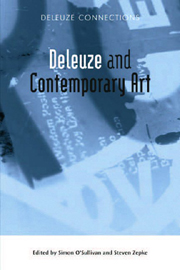Book contents
- Frontmatter
- Contents
- Acknowledgements
- List of Illustrations
- Introduction: Deleuze and Guattari and Contemporary Art
- POLITICS
- THE AESTHETIC PARADIGM
- SCENES AND ENCOUNTERS
- TECHNOLOGIES
- 13 Sign and Information: On Anestis Logothetis' Graphical Notations
- 14 Anti-Electra: Totemism and Schizogamy
- 15 Unimaginable Happenings: Material Movements in the Plane of Composition
- 16 BLOODCRYSTALPOLLENSTAR
- Notes on Contributors
- Index
15 - Unimaginable Happenings: Material Movements in the Plane of Composition
from TECHNOLOGIES
Published online by Cambridge University Press: 12 September 2012
- Frontmatter
- Contents
- Acknowledgements
- List of Illustrations
- Introduction: Deleuze and Guattari and Contemporary Art
- POLITICS
- THE AESTHETIC PARADIGM
- SCENES AND ENCOUNTERS
- TECHNOLOGIES
- 13 Sign and Information: On Anestis Logothetis' Graphical Notations
- 14 Anti-Electra: Totemism and Schizogamy
- 15 Unimaginable Happenings: Material Movements in the Plane of Composition
- 16 BLOODCRYSTALPOLLENSTAR
- Notes on Contributors
- Index
Summary
In 2005 W. J. T Mitchell published a book entitled What Do Pictures Want? The Lives and Loves of Images. It is a provocative title, one that raises the possibility that pictures might just be animated beings possessed of a vital life. In a coda to the second chapter, ‘What Do Pictures Want?’, Mitchell is asked by a number of respondents – including Charles Harrison, Lauren Berlant, Teresa de Lauretis, Terry Smith, Mary Kelly and others – to address the following ‘troubling’ questions: ‘What constitutes “animation” or vitality? What defines a living organism as distinct from an inanimate object? Isn't the notion of the living image a mere conceit that has gotten out of control?’ (Mitchell 2005: 50–1). It is questions such as these that have motivated the present essay. However, rather than ask what pictures want, it asks specifically what is it that pictures do? In fact, Mitchell suggests that, along with the inevitable question of what pictures mean or signify, we already ask the question of what they do. The focus of such questioning, he notes, is concerned with their power to effect our emotions and behaviour (Mitchell 2005: 28). Furthermore, such questions tend to be framed within the context of the artist's intentions or desires. In returning to the question of what pictures do, I propose to shift the locus of discussion from the picture as object to the event of picturing.
- Type
- Chapter
- Information
- Deleuze and Contemporary Art , pp. 266 - 285Publisher: Edinburgh University PressPrint publication year: 2010



